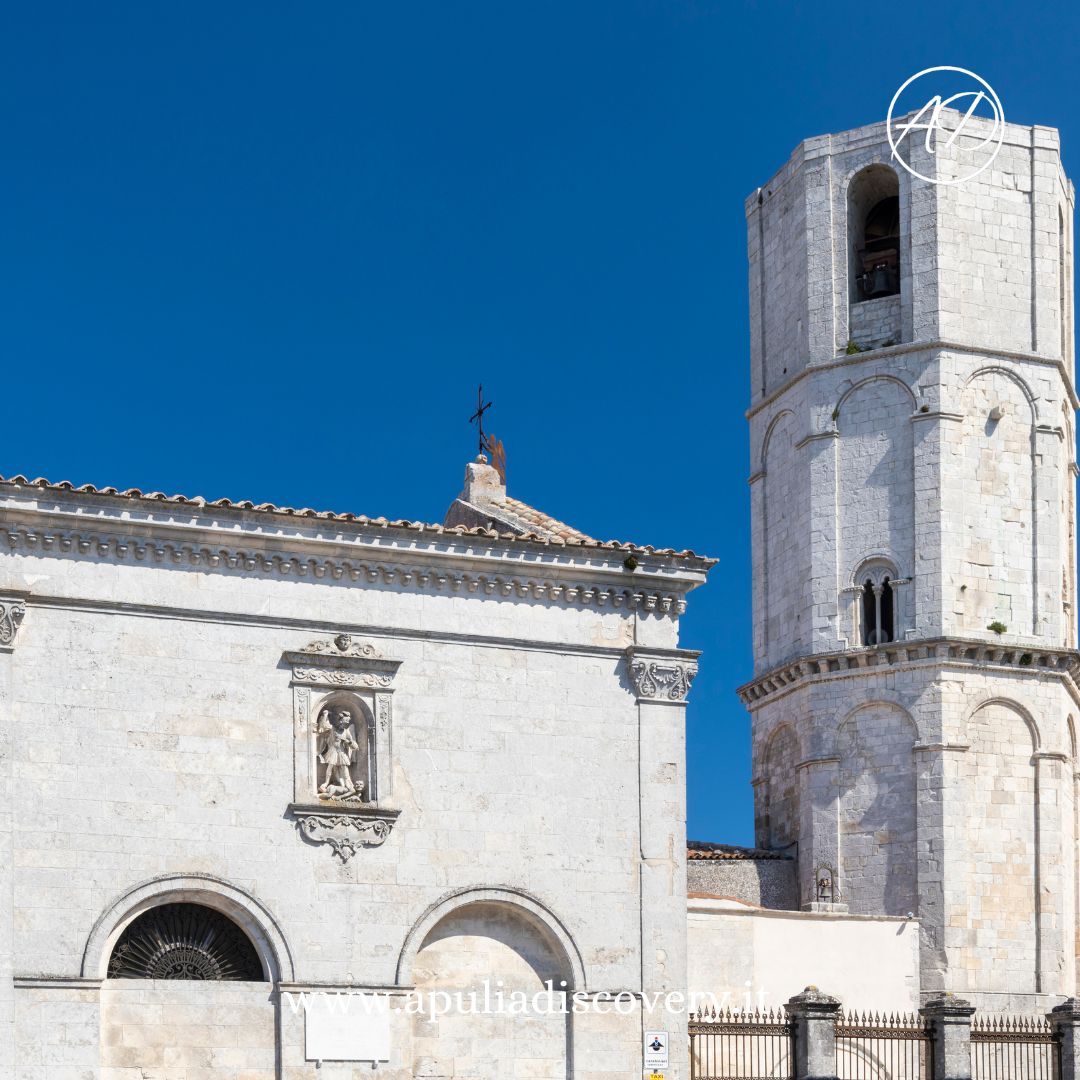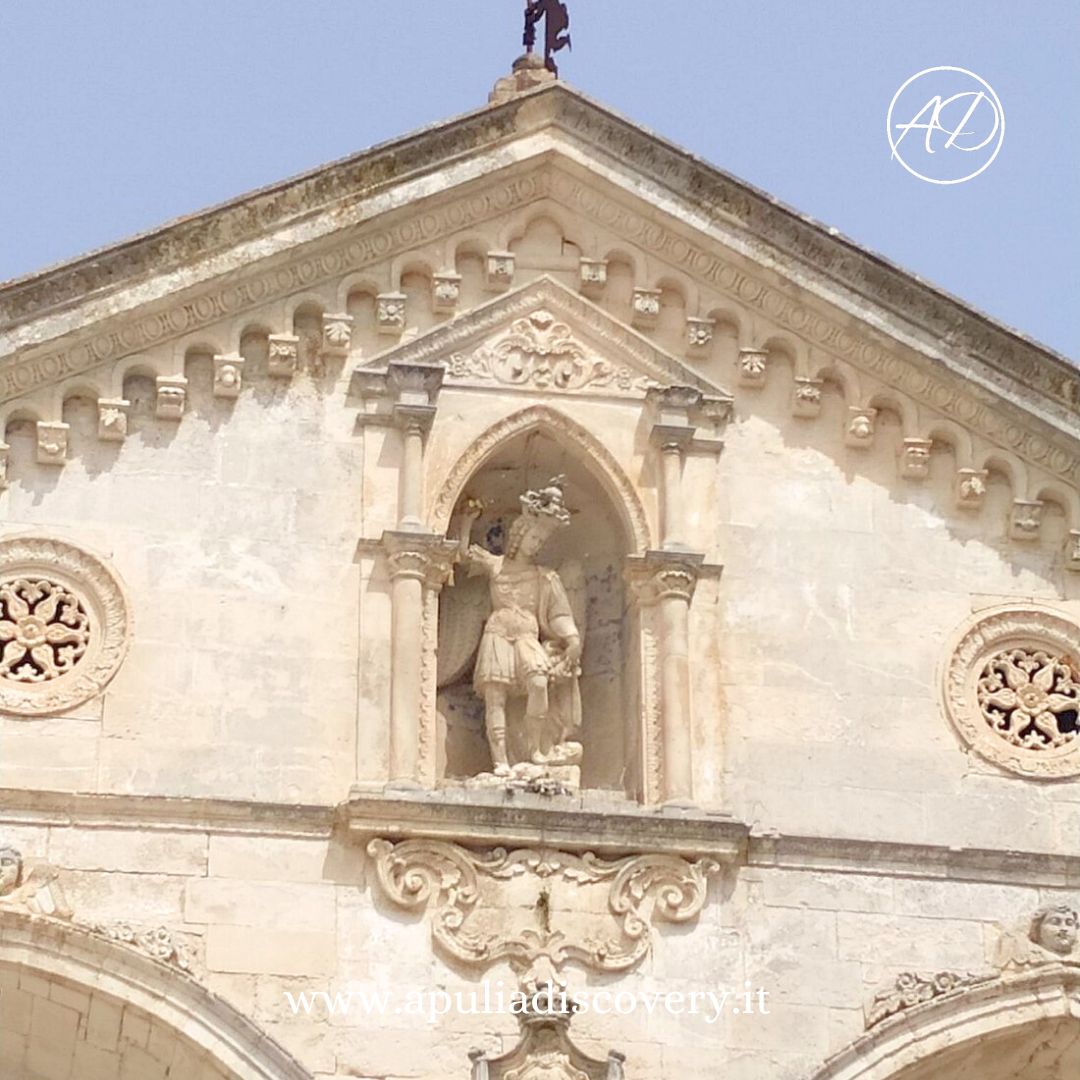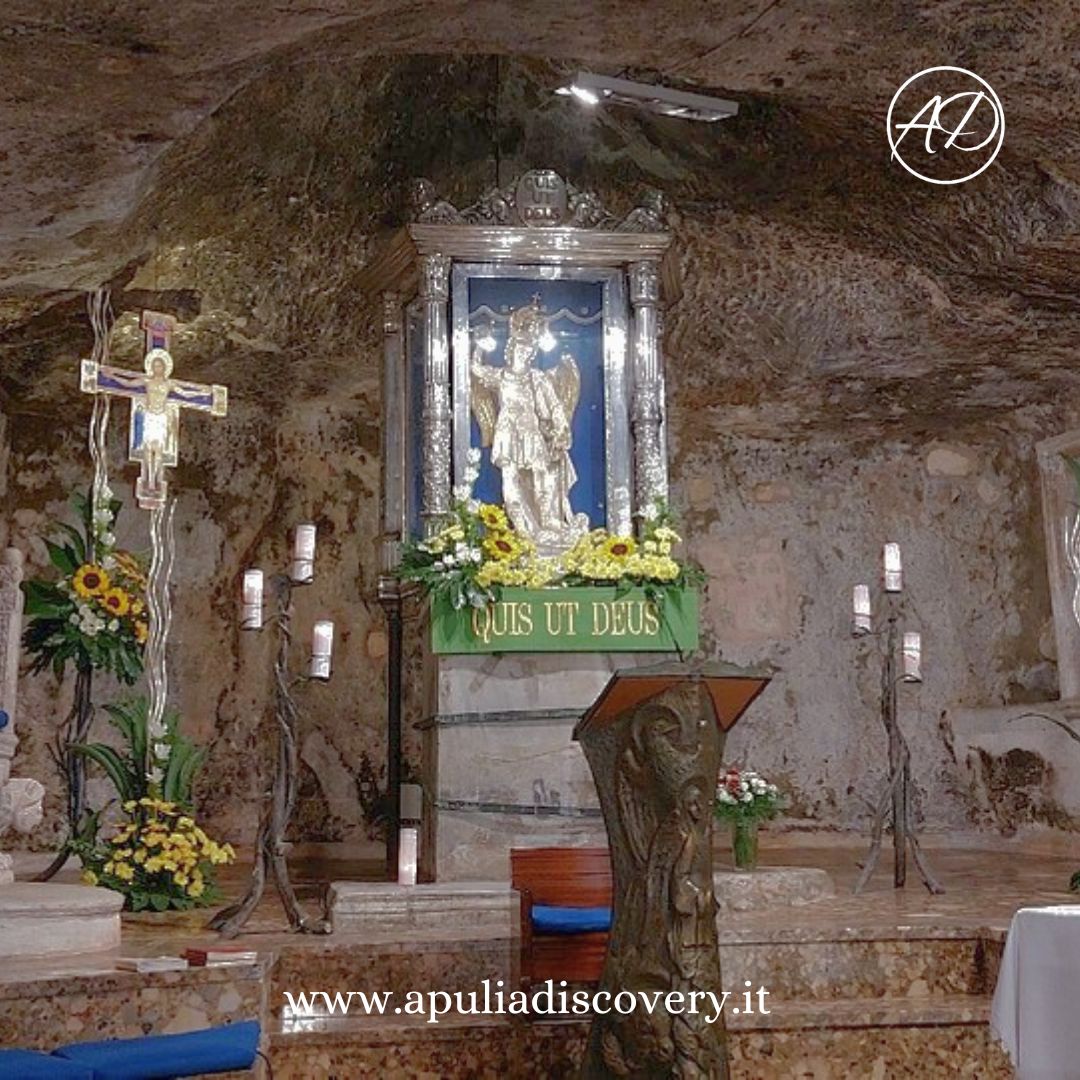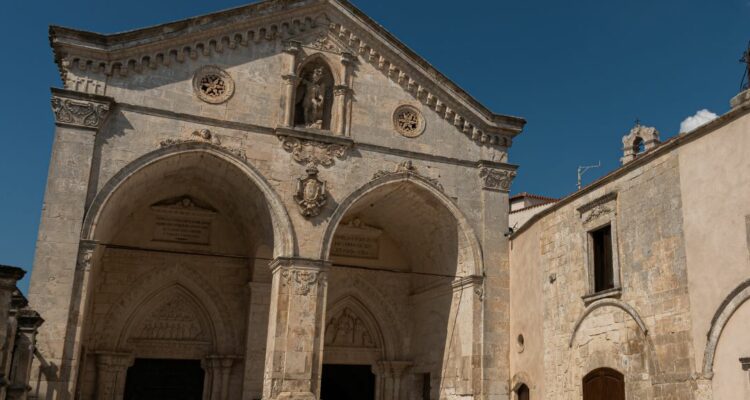Perched atop the Gargano peaks in Monte Sant’Angelo, the Sanctuary of Saint Michael the Archangel is a spiritual gem embedded in Italian history. Known as the Celestial Basilica, this millennial structure stands as a beacon of faith, attracting not only the faithful but also those seeking a deep connection with history and art. Its imposing silhouette, visible from afar, invites visitors to embark on a journey that is not just physical but also spiritual and cultural.
The history of the sanctuary is intertwined with that of Christianity and European culture. As a crossroads of civilizations and beliefs, this sacred site is like an open book into the past, offering visitors a unique experience where the divine meets the human. The Celestial Basilica is not just a place of worship, but a bridge between heaven and earth where mysticism merges with art to create an unforgettable experience.
Over the centuries, the sanctuary has witnessed countless historical events, becoming a symbol of resilience and hope. Its walls have seen kings, emperors, saints, and ordinary pilgrims pass through, each seeking something beyond earthly understanding. Its elevated position makes it a bastion of spirituality, a place where heaven and earth embrace, enveloped in an atmosphere of peace and solemnity.
History and Origin
 The Sanctuary of Saint Michael the Archangel at Monte Sant’Angelo has origins that are lost in the mists of time, with its founding dating back to the year 490 AD. This date marks not only the beginning of the Christian history of the site but also a crucial moment in the religious history of all Europe. According to tradition, the Archangel Michael appeared in a cave on the Gargano, an event that would catalyze Christian veneration in the region and beyond.
The Sanctuary of Saint Michael the Archangel at Monte Sant’Angelo has origins that are lost in the mists of time, with its founding dating back to the year 490 AD. This date marks not only the beginning of the Christian history of the site but also a crucial moment in the religious history of all Europe. According to tradition, the Archangel Michael appeared in a cave on the Gargano, an event that would catalyze Christian veneration in the region and beyond.
The archangel’s first appearance, with its miraculous nature and symbolic power, established the sanctuary as a place of divine protection and spiritual refuge. The cave, at the center of the apparition, soon became a pilgrimage and veneration site, attracting devotees from all over the Christian world.
During the Lombard period, the sanctuary gained even more importance. The Lombards, a Germanic people who dominated much of Italy in the early Middle Ages, embraced the cult of Saint Michael, seeing in the archangel a figure of protection and guidance. Under their rule, the Sanctuary of Saint Michael became a focal point of the Michaelic cult, a reference point not only for faith but also for the cultural and political identity of the Lombard people.
The sanctuary’s strategic position, perched atop a mountain and overlooking the Adriatic Sea, contributed to its fame. This location provided both physical and spiritual refuge for pilgrims over the centuries and symbolized the ascent from the human to the divine, from earth to heaven.
Throughout the ages, the sanctuary has undergone various changes and restorations but has always maintained its importance as a place of prayer and reflection. Every stone, fresco, and sculpture inside the sanctuary tells a story, a piece of the puzzle of a narrative that spans centuries of faith, art, and culture.
Architecture and Art
 The Sanctuary of Saint Michael the Archangel is an architectural masterpiece standing imposingly on the Gargano. Its structure is a sublime blend of Romanesque and Byzantine art, a fusion that reflects the rich history and cultural diversity of the area. Every architectural element of the sanctuary speaks of a past where different artistic and spiritual currents intertwined, creating a one-of-a-kind masterpiece.
The Sanctuary of Saint Michael the Archangel is an architectural masterpiece standing imposingly on the Gargano. Its structure is a sublime blend of Romanesque and Byzantine art, a fusion that reflects the rich history and cultural diversity of the area. Every architectural element of the sanctuary speaks of a past where different artistic and spiritual currents intertwined, creating a one-of-a-kind masterpiece.
The famous cave, the sanctuary’s beating heart, is much more than a simple cavern. It is a sanctuary within the sanctuary, a sacred place where heaven seems to touch the earth. This silent and solemn chamber, where the Archangel Michael is believed to have appeared, is a place for deep meditation. The cave walls are adorned with sacred frescoes and iconography that tell the story of the archangel, each narrating a page from Christian tradition and popular devotion.
The devotional museum, located within the complex, is a treasure trove of sacred art. It houses an impressive collection of artwork, relics, and artifacts spanning various historical periods, each telling a part of the sanctuary’s history and its importance in Christianity. These works of art are not just objects of beauty, but also tangible testimonies of faith, devotion, and history. The museum is a place where the past meets the present, where every visitor can get close to a spiritual and cultural legacy that has endured through the centuries.
Symbolism and Mystical Meanings
 The Sanctuary of Saint Michael the Archangel is not only a historical place of worship but also a center of symbolism and mystical meaning. Its architecture, location, and every element within are imbued with symbolism that extends beyond orthodox Christianity, touching upon realms of esotericism and profound spirituality.
The Sanctuary of Saint Michael the Archangel is not only a historical place of worship but also a center of symbolism and mystical meaning. Its architecture, location, and every element within are imbued with symbolism that extends beyond orthodox Christianity, touching upon realms of esotericism and profound spirituality.
The sanctuary’s location atop a mountain is no coincidence. It symbolizes the ascent of the soul toward the divine, a pilgrimage that is both physical and spiritual. The cave, the site of the angelic apparition, represents the meeting point between the earthly and the celestial, where the human and divine realms connect. This cave, with its walls carved by time and adorned with sacred representations, serves as a bridge between heaven and earth, between the visible and the invisible.
The symbols in the sanctuary speak a universal language of faith and mysticism. Every icon, fresco, and statue carries a deeper meaning, a story beyond its aesthetic appearance. These symbols narrate stories of divine protection, spiritual battles, redemption, and salvation, creating a narrative that intertwines Christianity with older traditions and beliefs.
Additionally, the sanctuary is set against a backdrop of nature and landscapes that amplify its mystical significance. The view from the sanctuary, stretching from the sea on the horizon to the surrounding hills, is a constant reminder of the grandeur of creation and the pervasive presence of the divine in the natural world.
The Sanctuary in the Middle Ages
During the Middle Ages, the Sanctuary of Saint Michael the Archangel in Monte Sant’Angelo took on a prominent role in the European religious and cultural landscape. In this period, the sanctuary not only flourished as a pilgrimage site but also established itself as a powerful symbol of spiritual resilience and unwavering faith.
The sanctuary’s strategic location at the crossroads of important pilgrimage routes made it a meeting point for faithful people from all over Europe. It was considered one of the four main pilgrimage destinations in Western Christianity, alongside Rome, Santiago de Compostela, and Jerusalem. Pilgrims undertook long and dangerous journeys to reach the Gargano, driven by faith and a desire to receive the Archangel Michael’s blessing and protection.
Moreover, the sanctuary became a stage for significant historical events. It hosted meetings between monarchs, served as a site for important political and spiritual decisions, and offered refuge for those seeking protection and guidance in uncertain times. Its influence extended beyond religious boundaries, impacting the politics and culture of the era.
During the Middle Ages, the sanctuary found itself at the center of various conflicts and changes. Its survival and prosperity in turbulent periods are a testament to the strong bond between the surrounding community and the faith it represented. The sanctuary became a symbol of resilience and hope, a beacon of light in an era often characterized by darkness and disorder.
Evolution Over Time
The Sanctuary of Saint Michael the Archangel has passed through many historical phases, evolving from a pagan worship site to one of the most important Christian basilicas. Each era has left its mark, contributing to the rich cultural and spiritual fabric that defines the sanctuary today.
The origins of the sanctuary date back to a time when the site was likely a place of pagan worship, as suggested by the presence of a natural cave that ancient beliefs often saw as a portal to the divine. With the Christianization of the site following the Archangel Michael’s apparitions, the cave and its surroundings were transformed into a major Christian worship center.
Over the centuries, the sanctuary has undergone significant architectural and artistic changes. Every new construction, modification, or addition reflected not only the artistic and architectural trends of the time but also changes in spirituality and religious practices. From the Lombards to the Normans and through the Angevin and Swabian periods, each ruling power left its mark, enriching the sanctuary with new stylistic and symbolic elements.
The sanctuary has also borne witness to the ongoing evolution of society and religion. It has seen the transition from more archaic religious practices to more structured and organized forms of worship. It has served as a point of reference in times of crisis and change, offering a sense of continuity and stability.
The Cave of Saint Michael
The Cave of Saint Michael, located in the heart of the sanctuary at Monte Sant’Angelo, is a place of extraordinary spiritual and historical significance. Considered a sanctuary within the sanctuary, this natural cave is the fulcrum around which the entire sacred complex revolves.
The entrance to the cave, a simple yet imposing opening, leads the faithful into an environment charged with palpable spirituality. The rough rock walls, which have heard centuries of prayers and supplications, are silent witnesses to a deep and continuous faith. Inside, the atmosphere is more intimate and collected, inviting visitors to moments of intense prayer and reflection.
The cave, with its simplicity and austerity, reminds pilgrims of God’s closeness in silence and solitude. The environment, devoid of excessive decorations, focuses attention on the spiritual significance of the place, making the presence of the Archangel Michael tangible. Here, history intertwines with legend, creating a bridge between past and present, between the divine and the human.
The Apparitions of the Archangel Michael
The four apparitions of the Archangel Michael in Monte Sant’Angelo shaped the destiny and sacred character of the sanctuary, transforming it into one of Christianity’s most revered sites. These miraculous events profoundly marked the site’s history and the collective imagination of the faithful.
The first apparition, which took place in 490 AD, marked the beginning of the transformation of the site into a Christian worship center. According to tradition, the Archangel Michael appeared to Bishop Lorenzo Maiorano, declaring the cave as a sacred place consecrated by him. This extraordinary event marked the sanctuary’s birth and the start of a long history of veneration.
Subsequent apparitions further solidified the sanctuary’s importance. Each miraculous event contributed to spreading the site’s fame, attracting pilgrims and devotees from all corners of the Christian world. These apparitions not only established the cave as a meeting place between heaven and earth but also consolidated Monte Sant’Angelo’s role as a spiritual reference point in Europe’s religious geography.
The Sanctuary in Popular Culture
The Sanctuary of Saint Michael has had a significant influence on popular culture, becoming a source of inspiration for artists, writers, and filmmakers. Its history and allure have found expression in various art forms, spreading its image far beyond the borders of Christian faith.
Literary works, paintings, sculptures, and films have captured and reinterpreted the sanctuary’s mystical beauty and legends. The figure of the Archangel Michael, in particular, has been the subject of numerous artistic representations, exalting his role as protector and spiritual guide. These works have helped make the Sanctuary of Saint Michael a universal symbol of divine protection and the fight against evil.
The sanctuary has also been cited in music, poetry, and theatrical works, symbolizing strength, hope, and salvation. Its presence in popular culture testifies to the wide-ranging influence of this sacred site over the centuries, transforming from a simple place of worship into a globally resonant cultural icon.
UNESCO Recognition
In 2011, the Sanctuary of Saint Michael the Archangel was awarded the prestigious UNESCO World Heritage status. This recognition not only affirms the sanctuary’s architectural and artistic value but also emphasizes its importance as a unique witness to human history and culture.
Its inclusion in the UNESCO list acknowledges the sanctuary’s extraordinary universality, transcending geographical and cultural barriers. With its rich history, distinctive architecture, and profound religious and cultural significance, the sanctuary has been identified as a treasure of humanity worthy of preservation and protection for future generations.
UNESCO recognition highlights the sanctuary’s central role in the history of Christianity and in European cultural heritage. It symbolizes the continuity and evolution of faith, art, and culture through the centuries, representing a meeting point between different religious, artistic, and historical currents.
Modern Pilgrimage Experience
Today, the Sanctuary of Saint Michael the Archangel continues to be a beloved pilgrimage destination, attracting thousands of people annually from all over the world. This sacred site offers a unique experience that weaves history, culture, and spirituality in an environment of extraordinary natural and architectural beauty.
Visitors to the sanctuary are immersed in an atmosphere of peace and tranquility, far from the noise of everyday life. The path to the cave, the breathtaking view of the surrounding landscape, and the majestic architecture of the complex create an intensely spiritual and reflective experience. Many pilgrims describe their visit to the sanctuary as a moment of deep spiritual connection, a refreshing pause for both body and soul.
The Sanctuary’s Influence on Christianity
The Sanctuary of Saint Michael the Archangel has significantly impacted Christianity, influencing various religious practices and traditions. Its history is intimately linked to the evolution of Christian faith in Europe, serving as a spiritual reference point and source of inspiration for the faithful, saints, popes, and pilgrims over the centuries.
The Archangel Michael’s apparitions and the resulting veneration have enriched Christianity’s fabric with new dimensions of faith and devotion. The sanctuary has become a symbol of divine presence and protection, a place where the barrier between heaven and earth seems to thin.
The Sanctuary’s Importance to the Local Community
The Sanctuary of Saint Michael the Archangel is not only a global place of worship; it is also a fundamental element for the economy, culture, and identity of the local community. For the residents of Monte Sant’Angelo and the surrounding areas, the sanctuary is a source of pride and a central reference point in their daily lives.
The sanctuary’s importance extends to the local economy, as religious tourism represents a significant part of the region’s economic activity. Hotels, restaurants, souvenir shops, and tour guides rely on the steady flow of pilgrims and visitors for their livelihood.
Culturally, the sanctuary strongly influences the community’s collective identity. Religious festivals, celebrations, and traditions related to the sanctuary are opportunities for gathering and expressing local culture, reinforcing the sense of belonging and historical continuity.
In conclusion, the Sanctuary of Saint Michael the Archangel is not just a historical monument or pilgrimage site; it is a living place that continues to influence and inspire the faith, culture, and daily lives of millions of people worldwide.
FAQ – Frequently Asked Questions
Q: What is the history of the Sanctuary of Saint Michael the Archangel?
A: The Sanctuary of Saint Michael the Archangel in Monte Sant’Angelo has ancient origins. It was founded in 490 AD after the first apparition of the Archangel Michael and became an important center of Christian worship and pilgrimage.
Q: What makes the Sanctuary of Saint Michael unique?
A: The sanctuary’s uniqueness comes from its remarkable history of angelic apparitions, its architecture combining Romanesque and Byzantine elements, and its role in Christianity as a significant pilgrimage site.
Q: Is the sanctuary open to visitors year-round?
A: Yes, the sanctuary is generally open to visitors throughout the year, but it’s advisable to check specific hours and potential seasonal changes on the official website or by contacting the sanctuary directly.
Q: Are tour guides available for visitors?
A: Yes, tour guides are available to provide detailed insights into the sanctuary’s history, art, and spirituality.
Q: What are the main festivals celebrated at the sanctuary?
A: The main festivals include May 8th, the anniversary of the first apparition, and September 29th, the Feast of Saint Michael the Archangel.
Q: Has the sanctuary been recognized by UNESCO?
A: Yes, in 2011, the sanctuary was included on the UNESCO World Heritage List as part of the site “The Longobards in Italy: Places of Power.”
Q: Are there accommodation facilities near the sanctuary?
A: Yes, there are various accommodation options nearby, ranging from hotels to guest houses, catering to pilgrims and tourists.
The Sanctuary of Saint Michael the Archangel, with its millennial history and profound spirituality, remains a meeting point between past and present, a junction between heaven and earth. This sacred site, wrapped in an aura of mystery and sacredness, is a living symbol of faith and culture, a place that continues to inspire and move people.
Visiting the Sanctuary of Saint Michael the Archangel means immersing oneself in a rich and complex history made of legends, faith, and art. Every stone, fresco, and corner of this place tells a story that is an integral part of spiritual and human history. The sanctuary is not just a historical monument or religious site; it is a living testament to how faith, history, and culture can intertwine to create a unique place.
For the faithful, history lovers, and art enthusiasts, the sanctuary offers a window into a world where time seems to have stopped, inviting each visitor to reflect, meditate, and connect with something beyond mere material existence. In this sense, the Sanctuary of Saint Michael the Archangel is not just a destination, but a journey within oneself, discovering the deepest roots of our humanity and spirituality.

